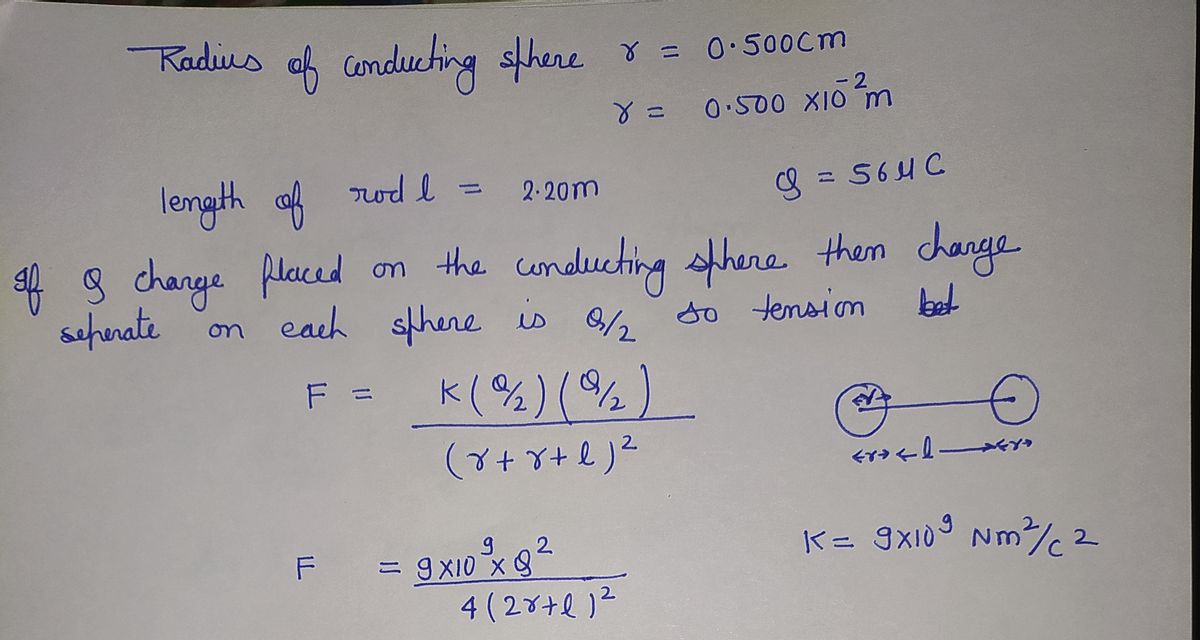
College Physics
11th Edition
ISBN: 9781305952300
Author: Raymond A. Serway, Chris Vuille
Publisher: Cengage Learning
expand_more
expand_more
format_list_bulleted
Concept explainers
Question

Transcribed Image Text:Two identical conducting spheres each having a radius of 0.500 cm are connected by a light 2.20 m long conducting wire. A charge of 56.0 µC is placed on one of the conductors. Assume the surface distribution of charge on each sphere is uniform. Determine the tension in the wire.
Expert Solution
arrow_forward
Step 1

Step by stepSolved in 2 steps with 2 images

Knowledge Booster
Learn more about
Need a deep-dive on the concept behind this application? Look no further. Learn more about this topic, physics and related others by exploring similar questions and additional content below.Similar questions
- In an electrically neutral insulator, electrons are *not* able to move around freely as they can in a conductor. How, then, is it possible for an external electric field to induce a charge distribution in a chunk of insulating material?arrow_forwardIn the figure two tiny conducting balls of identical mass m and identical charge q hang from nonconducting threads of length L. Assume that is so small that tan 0 can be replaced by its approximate equal, sin 8. If L = 140 cm, m = 10 g, and x = 6.0 cm, what is the magnitude of q? L ᏀᎾ Ꮎ Number i L 9 0.0000009165 Units nCarrow_forwardTwo tiny conducting spheres are identical and carry charges of -19.5 μC and +41.5 μC. They are separated by a distance of 3.51 cm. (a) What is the magnitude of the force that each sphere experiences? (b) The spheres are brought into contact and then separated to a distance of 3.51 cm. Determine the magnitude of the force that each sphere now experiences. (a) Number i 5940000000000000 Units N (b) Number i 8810000000000 Units Narrow_forward
- Two parallel, thin, L×L�×� conducting plates are separated by a distance d�, as shown. Let L=�=2.5 m, and d=�=2.0 mm. A charge of ++6.5μC�C is placed on one plate, and a charge of −−6.5μC�C is placed on the other plate. a) What is the magnitude of charge density on the inside surfae of each plate in Coulombs per squae meter? b) What is the magnitude of the electric field between the plates? I was able to find the charge density easily. I am not certain about the electric field.arrow_forwardA conducting sphere of radius r1 = 0.21 m has a total charge of Q = 1.6 μC. A second uncharged conducting sphere of radius r2 = 0.29 m is then connected to the first by a thin conducting wire. The spheres are separated by a very large distance compared to their size. What is the total charge on sphere two, Q2 in coulombs?arrow_forwardEx:Region y 0 is a dielectric medium (€,r1 = 2). If there is a surface charge of p, = 2 n (а) А (3,-2,2) (b) В (-4,1,5) on the conductor, determine E and D at т2arrow_forward
- Problem 6: A conducting sphere of radius r1 = 0.18 m has a total charge of Q = 1.4 μC. A second uncharged conducting sphere of radius r2 = 0.42 m is then connected to the first by a thin conducting wire. The spheres are separated by a very large distance compared to their size. What is the total charge on sphere two, Q2 In coulombsarrow_forwardCharge is distributed uniformly along a long straight wire. The electric field 52 cm from the wire is measured to be 14,500 N/C. What is the linear charge density of the wire? The linear charge density, K = Units Select an answer varrow_forwardThree identical metallic conducting spheres carry the following charges: q1 = +4.60 μC, q2 = +1.80 μC, and q3 = −1.60 μC. The spheres that carry the charges q1 and q2 are brought into contact. Then they are separated. After that, one of those two spheres is brought into contact with the third sphere that carries the charge q3; those two are then separated as well. How many excess (or deficiency) electrons make up the final charge on the third sphere?arrow_forward
arrow_back_ios
arrow_forward_ios
Recommended textbooks for you
 College PhysicsPhysicsISBN:9781305952300Author:Raymond A. Serway, Chris VuillePublisher:Cengage Learning
College PhysicsPhysicsISBN:9781305952300Author:Raymond A. Serway, Chris VuillePublisher:Cengage Learning University Physics (14th Edition)PhysicsISBN:9780133969290Author:Hugh D. Young, Roger A. FreedmanPublisher:PEARSON
University Physics (14th Edition)PhysicsISBN:9780133969290Author:Hugh D. Young, Roger A. FreedmanPublisher:PEARSON Introduction To Quantum MechanicsPhysicsISBN:9781107189638Author:Griffiths, David J., Schroeter, Darrell F.Publisher:Cambridge University Press
Introduction To Quantum MechanicsPhysicsISBN:9781107189638Author:Griffiths, David J., Schroeter, Darrell F.Publisher:Cambridge University Press Physics for Scientists and EngineersPhysicsISBN:9781337553278Author:Raymond A. Serway, John W. JewettPublisher:Cengage Learning
Physics for Scientists and EngineersPhysicsISBN:9781337553278Author:Raymond A. Serway, John W. JewettPublisher:Cengage Learning Lecture- Tutorials for Introductory AstronomyPhysicsISBN:9780321820464Author:Edward E. Prather, Tim P. Slater, Jeff P. Adams, Gina BrissendenPublisher:Addison-Wesley
Lecture- Tutorials for Introductory AstronomyPhysicsISBN:9780321820464Author:Edward E. Prather, Tim P. Slater, Jeff P. Adams, Gina BrissendenPublisher:Addison-Wesley College Physics: A Strategic Approach (4th Editio...PhysicsISBN:9780134609034Author:Randall D. Knight (Professor Emeritus), Brian Jones, Stuart FieldPublisher:PEARSON
College Physics: A Strategic Approach (4th Editio...PhysicsISBN:9780134609034Author:Randall D. Knight (Professor Emeritus), Brian Jones, Stuart FieldPublisher:PEARSON

College Physics
Physics
ISBN:9781305952300
Author:Raymond A. Serway, Chris Vuille
Publisher:Cengage Learning

University Physics (14th Edition)
Physics
ISBN:9780133969290
Author:Hugh D. Young, Roger A. Freedman
Publisher:PEARSON

Introduction To Quantum Mechanics
Physics
ISBN:9781107189638
Author:Griffiths, David J., Schroeter, Darrell F.
Publisher:Cambridge University Press

Physics for Scientists and Engineers
Physics
ISBN:9781337553278
Author:Raymond A. Serway, John W. Jewett
Publisher:Cengage Learning

Lecture- Tutorials for Introductory Astronomy
Physics
ISBN:9780321820464
Author:Edward E. Prather, Tim P. Slater, Jeff P. Adams, Gina Brissenden
Publisher:Addison-Wesley

College Physics: A Strategic Approach (4th Editio...
Physics
ISBN:9780134609034
Author:Randall D. Knight (Professor Emeritus), Brian Jones, Stuart Field
Publisher:PEARSON